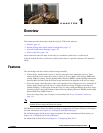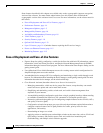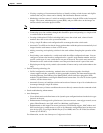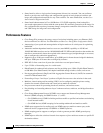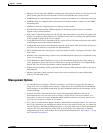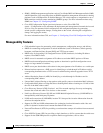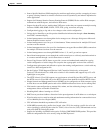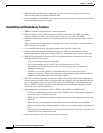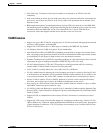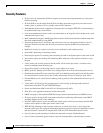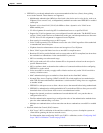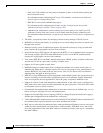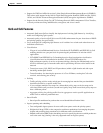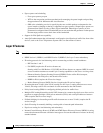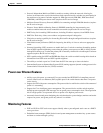
1-8
Catalyst 3750 Switch Software Configuration Guide
OL-8550-09
Chapter 1 Overview
Features
• DHCP Snooping enhancement to support the selection of a fixed string-based format for the
circuit-id sub-option of the Option 82 DHCP field
• Increased support for LLPD-MED by allowing the switch to grant power to the power device (PD),
based on the power policy TLV request
Availability and Redundancy Features
• HSRP for command switch and Layer 3 router redundancy
• Enhanced object tracking, which separates the tracking mechanism from HSRP and creates a
separate, standalone tracking process that can be used by processes other than HSRP
• Automatic stack master re-election for replacing stack masters that become unavailable (failover
support)
The newly elected stack master begins accepting Layer 2 traffic in less than 1 second and Layer 3
traffic between 3 to 5 seconds.
• Cross-stack EtherChannel for providing redundant links across the switch stack
• UniDirectional Link Detection (UDLD) and aggressive UDLD for detecting and disabling
unidirectional links on fiber-optic interfaces caused by incorrect fiber-optic wiring or port faults
• IEEE 802.1D Spanning Tree Protocol (STP) for redundant backbone connections and loop-free
networks. STP has these features:
–
Up to 128 spanning-tree instances supported
–
Per-VLAN spanning-tree plus (PVST+) for load balancing across VLANs
–
Rapid PVST+ for load balancing across VLANs and providing rapid convergence of
spanning-tree instances
–
UplinkFast, cross-stack UplinkFast, and BackboneFast for fast convergence after a
spanning-tree topology change and for achieving load balancing between redundant uplinks,
including Gigabit uplinks and cross-stack Gigabit uplinks
• IEEE 802.1s Multiple Spanning Tree Protocol (MSTP) for grouping VLANs into a spanning-tree
instance and for providing multiple forwarding paths for data traffic and load balancing and rapid
per-VLAN Spanning-Tree plus (rapid-PVST+) based on the IEEE 802.1w Rapid Spanning Tree
Protocol (RSTP) for rapid convergence of the spanning tree by immediately changing root and
designated ports to the forwarding state
• Optional spanning-tree features available in PVST+, rapid-PVST+, and MSTP mode:
–
Port Fast for eliminating the forwarding delay by enabling a port to immediately change from
the blocking state to the forwarding state
–
BPDU guard for shutting down Port Fast-enabled ports that receive bridge protocol data units
(BPDUs)
–
BPDU filtering for preventing a Port Fast-enabled port from sending or receiving BPDUs
–
Root guard for preventing switches outside the network core from becoming the spanning-tree
root
–
Loop guard for preventing alternate or root ports from becoming designated ports because of a
failure that leads to a unidirectional link
• Equal-cost routing for link-level and switch-level redundancy




